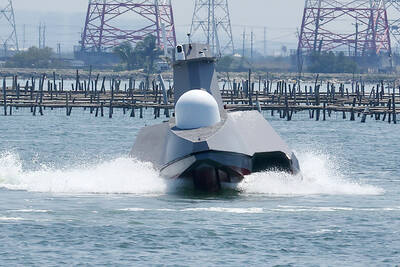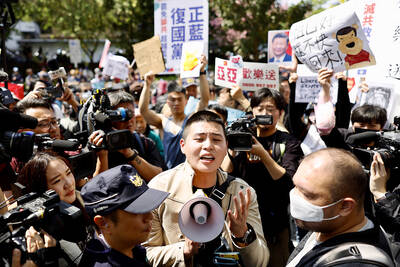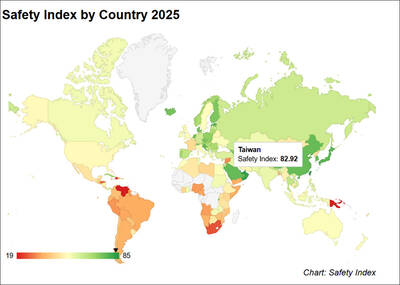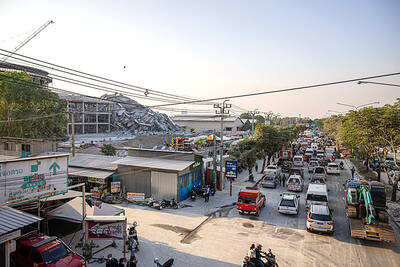Singapore’s main exports fell 19.2 percent year on year in April, government data released yesterday showed, as the city-state struggles to find a way out of its worst recession in decades.
Shipments of electronics extended their sharp fall from March and petrochemicals accelerated their decline to weigh down a strong showing by pharmaceuticals, the figures showed.
Non-oil domestic exports (NODX) totaled S$11.32 billion (US$7.7 billion) last month, the trade development agency International Enterprise Singapore (IE Singapore) said.
BELT TIGHTENING
NODX was down 17.3 percent in March and 23.8 percent in February. Global demand for Asian exports, including goods from Singapore, has been dwindling as the economic crisis forces consumers to tighten their belts.
IE Singapore said last month’s decline was “due to contractions in both electronic and non-electronic” exports.
“The bottom line, together with the China, Taiwan and South Korean data, is that Singapore’s April NODX data is a reminder that the road to recovery is a bumpy one,” said Song Seng Wun, a regional economist at CIMB-GK Research.
Electronics exports tumbled 25.6 percent last month, almost identical to the March decline, largely due to lower demand for personal computer parts, integrated circuits and disc drives.
But shipments of pharmaceuticals, another major export, surged 41.16 percent, reversing a 3.8 percent shrinkage in March.
DIVE
However, this was not enough to turn exports around as petrochemicals dived 39.2 percent last month, following a 31.6 percent fall the previous month.
“If not for a strong pharma showing, overall NODX would have declined by a larger magnitude,” Song said.
Exports to Singapore’s top 10 overseas markets declined, notably to the EU, for which shipments contracted 31 percent after a 24 percent drop in March, and the US, which fell 35 percent after a 31 percent drop in March.
Song said this highlighted the “still fragile state of global demand” for exports.
Singapore fell into recession in the third quarter last year as the global downturn sparked by the collapse of the US subprime, or risky, mortgage market intensified and spilled over into the larger economy.
The country’s trade-dependent economy is expected to shrink by between 6 percent and 9 percent this year as the country grapples with its worst economic downturn since independence 44 years ago.

ENDEAVOR MANTA: The ship is programmed to automatically return to its designated home port and would self-destruct if seized by another party The Endeavor Manta, Taiwan’s first military-specification uncrewed surface vehicle (USV) tailor-made to operate in the Taiwan Strait in a bid to bolster the nation’s asymmetric combat capabilities made its first appearance at Kaohsiung’s Singda Harbor yesterday. Taking inspiration from Ukraine’s navy, which is using USVs to force Russia’s Black Sea fleet to take shelter within its own ports, CSBC Taiwan (台灣國際造船) established a research and development unit on USVs last year, CSBC chairman Huang Cheng-hung (黃正弘) said. With the exception of the satellite guidance system and the outboard motors — which were purchased from foreign companies that were not affiliated with Chinese-funded

PERMIT REVOKED: The influencer at a news conference said the National Immigration Agency was infringing on human rights and persecuting Chinese spouses Chinese influencer “Yaya in Taiwan” (亞亞在台灣) yesterday evening voluntarily left Taiwan, despite saying yesterday morning that she had “no intention” of leaving after her residence permit was revoked over her comments on Taiwan being “unified” with China by military force. The Ministry of the Interior yesterday had said that it could forcibly deport the influencer at midnight, but was considering taking a more flexible approach and beginning procedures this morning. The influencer, whose given name is Liu Zhenya (劉振亞), departed on a 8:45pm flight from Taipei International Airport (Songshan airport) to Fuzhou, China. Liu held a news conference at the airport at 7pm,

Taiwan was ranked the fourth-safest country in the world with a score of 82.9, trailing only Andorra, the United Arab Emirates and Qatar in Numbeo’s Safety Index by Country report. Taiwan’s score improved by 0.1 points compared with last year’s mid-year report, which had Taiwan fourth with a score of 82.8. However, both scores were lower than in last year’s first review, when Taiwan scored 83.3, and are a long way from when Taiwan was named the second-safest country in the world in 2021, scoring 84.8. Taiwan ranked higher than Singapore in ninth with a score of 77.4 and Japan in 10th with

GRIDLOCK: The National Fire Agency’s Special Search and Rescue team is on standby to travel to the countries to help out with the rescue effort A powerful earthquake rocked Myanmar and neighboring Thailand yesterday, killing at least three people in Bangkok and burying dozens when a high-rise building under construction collapsed. Footage shared on social media from Myanmar’s second-largest city showed widespread destruction, raising fears that many were trapped under the rubble or killed. The magnitude 7.7 earthquake, with an epicenter near Mandalay in Myanmar, struck at midday and was followed by a strong magnitude 6.4 aftershock. The extent of death, injury and destruction — especially in Myanmar, which is embroiled in a civil war and where information is tightly controlled at the best of times —